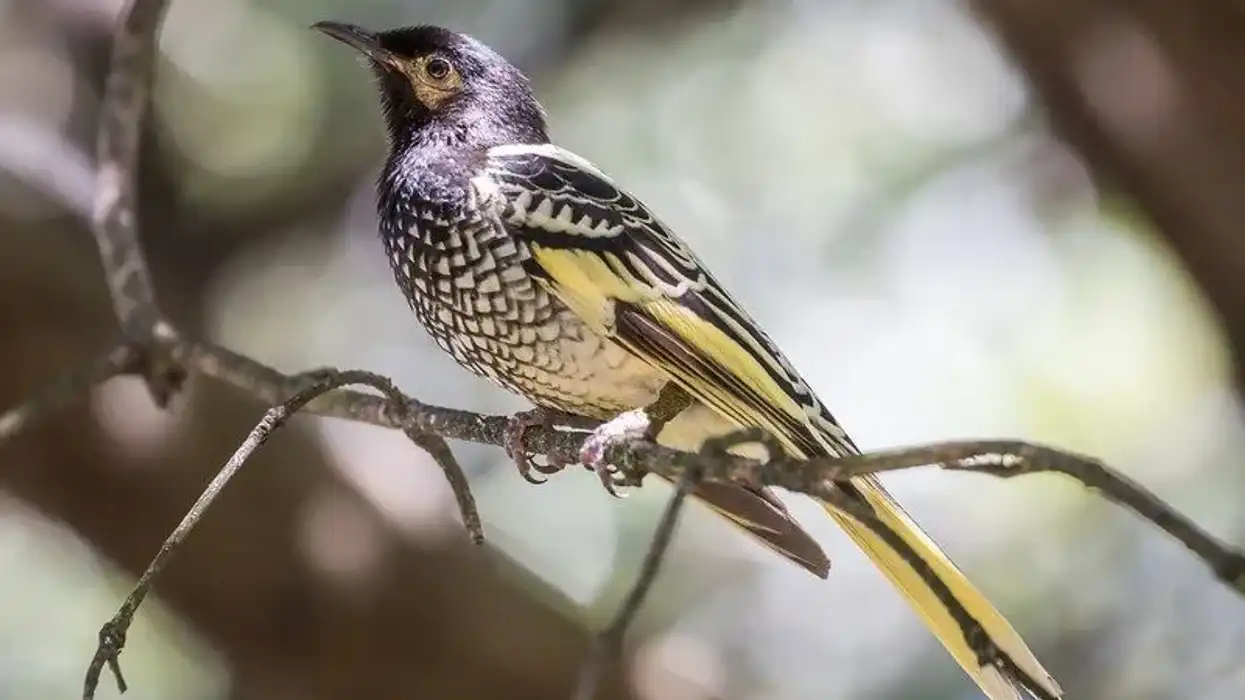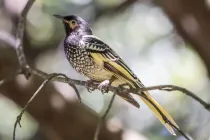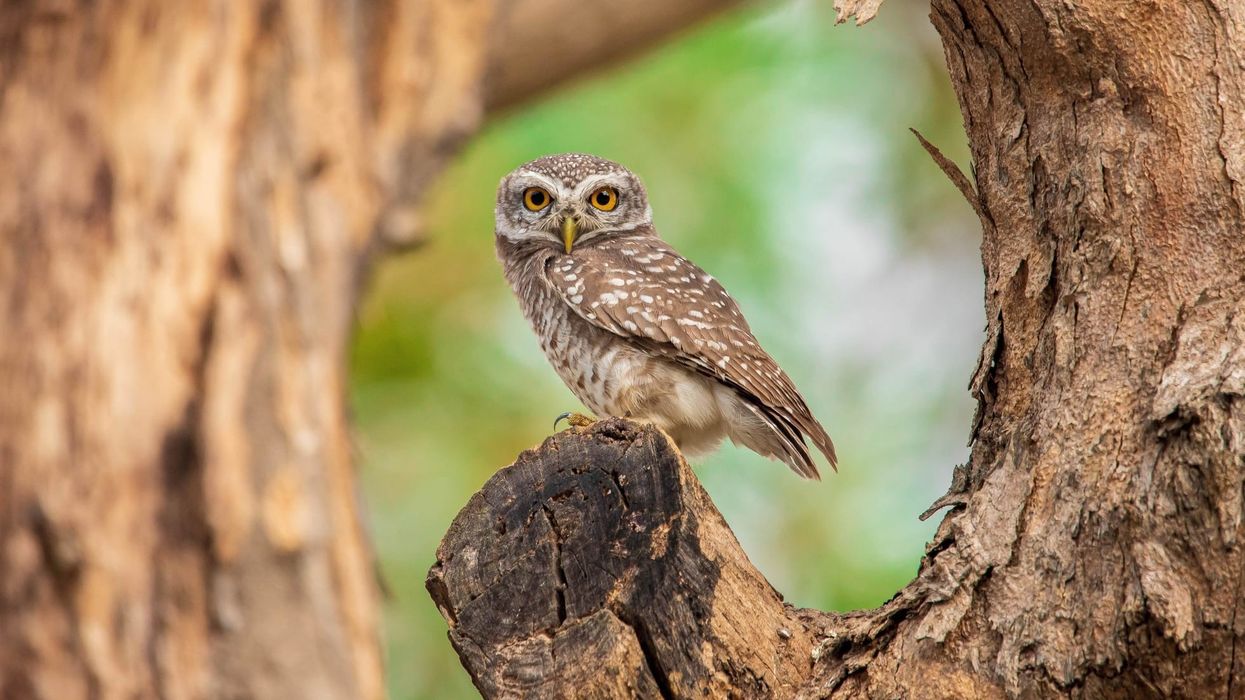The regent honeyeater (Anthochaera phrygia) is a species of bird endemic to south-eastern Australia.
These Australian birds are considered Critically Endangered due to the low number of birds left in the world. However, the regent honeyeater is categorized as a flagship species in its range, and the work done to conserve this species in the range has had fruitful results for other species too.
Researchers have found this species to be closely associated with wattlebirds. The species regent honeyeater was first described by George Shaw, the English naturalist in 1794.
In 1827, the species was moved to the genus Anthochaera by the naturalists Thomas Horsfield and Nicholas Aylward Vigors. Before this, the species of bird was known by the name of Xanthomyza phrygia. It was then put under the wattlebirds genus Anthochaera.
Identify these birds with the glossy black head and neck, pale yellow speckles in the breast region, and bright yellow and black feathers in the tail and wings. The bird feeds on nectar from eucalyptus and other species of mistletoe. The bird also feeds on insects and native or cultivated fruits.
Know more about the bird species in the upcoming topics.
Regent Honeyeater Interesting Facts
What type of animal is a regent honeyeater?
The regent honeyeater is a medium-sized black and yellow bird native to south-eastern Australia.
What class of animal does a regent honeyeater belong to?
The regent honeyeater is part of the genus Anthochaera in the class of Aves and the kingdom of Animalia. Part of the family Meliphagidae, the regent honeyeater is a passerine bird and is known to be closely related to wattlebirds.
Although the birds are native to the forests and woodlands in the wild of north-east Victoria, Sunshine Coast (Queensland), Great Dividing Range of New South Wales, central coast in New South Wales, and more, the recovery of the species needs to be shot up to keep them in the world.
The bird was earlier seen in South Australia and eastern Australia.
How many regent honeyeaters are there in the world?
The population of regent honeyeaters has declined at an alarming rate in recent times and although the population was estimated to be around 2300 individuals, the year 2010 saw only around 350-400 individuals left throughout the distribution of the bird in the wild.
The regent honeyeater is Critically Endangered and conservation efforts need to be implemented to save the population and increase in the region.
Where does a regent honeyeater live?
This woodland bird is endemic to most of its distribution areas and due to its flagship status, it is helping a lot of woodland fauna cope in this destructive environment. You will find these birds in the wild where they inhabit dry open forests and woodlands which include Box-Ironbark woodland and riparian forests in River Sheoak.
Regent honeyeaters are found in ironbark woodlands with high numbers of birds. The habitat needs to have some mature trees, an abundance of mistletoe, and a high canopy cover.
You will also find non-breeding birds of the species in the Spotted Gum forests and coastal Swamp Mahogany on the central coast and sometimes on the upper north coast. The birds are also seen sometimes on the south coast.
What is a regent honeyeater's habitat?
The regent honeyeater range map includes areas in north-east Victoria to the Sunshine Coast in Queensland, however, the population is scattered. You will also see the birds in north-eastern Victoria and in the western slopes of the Great Dividing Range of NSW and also on the central coast of this region.
In the breeding season, the birds were seen in the Bundarra-Barraba area of NSW and in Capertee Valley, along with north-eastern Victoria.
Regent honeyeater NSW range map includes places such as Brisbane Water, Bundarra-Barraba, Capertee Valley, Hastings-Macleay, Greater Blue Mountains, Hunter Valley, Mudgee-Wollar, Lake Macquarie, Richmond Woodlands, and Tuggerah. The Queensland distribution includes Traprock and Victoria in Australia including the Warby-Chiltern Box-Ironbark region.
Once commonly found in the wooded regions of eastern Australia and towards the west as Adelaide, but the birds have vanished from western Victoria and South Australia. The birds no longer exist in south-western Victoria.
Who do regent honeyeaters live with?
They are found in pairs or in colonies mostly. Native to Australia, these birds are seen breeding in pairs or loose colonies in the Box-Ironbark area in Victoria and the Bundarra-Barraba and Capertee Valley in NSW, Australia. The habitat is simple with forests and woodlands with many other species of birds living together in the wild.
The movements are in flocks.
How long does a regent honeyeater live?
The average lifespan of the regent honeyeater is around six years in the wild. The birds are found in their wild habitat living among other birds in harmony.
How do they reproduce?
The breeding season is from August to January during the southern spring-time and the summer-time. The breeding season matches with the flowering of the eucalyptus trees and mistletoe trees.
In a cup-shaped nest on trees, two or three eggs are laid by females. The bare nest in a tree along with the eggs is often predated by other birds and animals and the success rate of the nest of these birds is quite small.
Even males are tighter in number than females, which leads to less breeding and hence a major problem for the sustenance of the species. The nest is made in a tree, away from terrestrial animals.
The males and females breed in pairs or in loose colonies and the female species incubate the eggs. Both male and female birds feed the young.
What is their conservation status?
The conservation status of the birds is kept as Critically Endangered by the IUCN Red List and the species is deeply threatened by extinction if no proper measures are taken soon. The major reason to be threatened for the species is habitat loss, while there are other reasons too.
Efforts for conservation of the species are ongoing, however, as the tree habitats are decreasing, the birds are declining too. The Australian bush fire led to a tremendous decline in the population of the bird.
The regent honeyeater endangered status is due to the major loss of the Box-Ironbark forests where the birds make the nest and also is in need of nectar to fill their diet.
Regent Honeyeater Fun Facts
What do regent honeyeaters look like?
With a black head, black neck, and black upper breast, the regent honeyeater is a big bird that is threatened in this world. You will see a lemon yellow back a black-scaled back, the bird has a white underpart, black wings with yellow patches with a black tail and yellow edges.
Yellow bare skin is seen surrounding the black eye in males. Females are smaller in size with yellowish patches only under the eye.
Females have less black under the throats. Young are similar to females but have a paler bill.
How cute are they?
These birds are extremely beautiful and cute.
How do they communicate?
The regent honeyeater call is melodious and helps during reproduction.
How big is a regent honeyeater?
The birds are medium-sized and between 7.87-9.44 in (20-24 cm) in length.
The wingspan is up to 11.81 in (30 cm).
How fast can a regent honeyeater fly?
The regent honeyeater in flight can take on longer distances when following the flowering of their favored flora species.
The speed is not known, although known to be medium-fast.
How much does a regent honeyeater weigh?
The weight is between 0.07-0.11 lb (35 - 50 g).
What are the male and female names of the species?
The male and female birds are not known by different names. They are known as regent honeyeaters commonly.
What would you call a baby regent honeyeater?
A baby is called a young.
What do they eat?
The diet includes nectar from trees like mistletoe and eucalyptus. They also feed on native and cultivated fruits along with spiders and insects.
Are they dangerous?
They are not considered dangerous.
Would they make a good pet?
They are not considered pets and as numbers are already quite low, they should be allowed to grow in the forests with uninterrupted movements.
Did you know...
The song of these birds is being forgotten by the species themselves now as there are only a few members left. This has led to less breeding, accounting for fewer birds in the world further.
The nests are often predated by noisy miners (Manorina melanocephala). Other predators might include corvids, butcherbirds, and more.
Why are regent honeyeaters endangered?
The main reason is habitat loss which has led to a tremendous decline in the population.
Why are regent honeyeaters important?
The birds maintain an ecological balance in nature and the loss of this bird from the world will be disastrous.
*We've been unable to source an image of regent honeyeater and have used an image of New Holland honeyeater instead. If you are able to provide us with a royalty-free image of regent honeyeater, we would be happy to credit you. Please contact us at hello@kidadl.com










